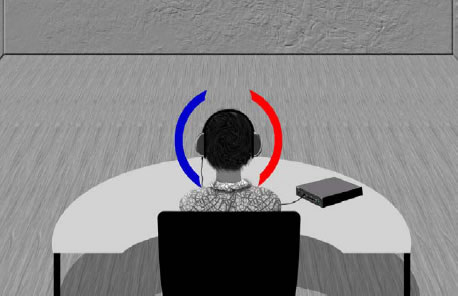Fluffy
Addicted to Fun and Learning
- Joined
- Sep 14, 2019
- Messages
- 856
- Likes
- 1,441
I've been experimenting lately with crossfeed with my headphones. The main issue I'm trying to resolve is avoiding sounds that are hard panned to one side. In headphones it sounds unnatural and irritating because it's isolated to only one ear. Of course, in speakers there is some leakage to the other ear so it's much more tolerable.
What I have to work with is EqualizerAPO. I don't have the Peace interface, and while I've heard it contains some sort of crossfeed option, I would like to have full control on what the crossfeed filter actually does, so I'm trying to make one manually using the available commands.
The first attempt was a simple copy between channels. For example, R channel having 90% of R audio and 10% of L audio, and vice versa. I played around with the ratios, and while it did manage to eliminate hard panned sounds, it sounded kind of unnatural and hurt the soundstage width too much.
So I tried to delve into more complex crossfeed arrangements. I found a VST plugin that I could apply in EQ APO named "BS2BR", that had 4 levels of crossfeed. I generally understand it's function and how it differ from a simple copy between channels – it copies one cannel's information to the other one while applying a high-shelf filter, thus resulting in more crossfeed in the lower frequencies and less in the higher ones. I suppose this gives a more realistic sound, because it imitates how low frequencies are less directional than high ones. The plugin interface gives basic information on the different parameters, but I don't quite understand what those parameters mean. For example:

A higher crossfeed level gives more separation. Here it's at 9.5 db, and in other configurations it's as low as 4.5. the cutoff frequency here is 650 hz, while in the narrower option it's at 700 hz. I vaguely understand how these affect the narrowness of the perceived soundstage, but I would be glad if someone with real knowledge could tell me what these parameters actually mean. Is the cutoff frequency when the high shelf filter begins? Is it it's center frequency? What is its slope? And what does the crossfeed level mean? It's a 9.5 db boost/cut of what exactly?
Anyway, I did try to replicate that plugin's effect using the built in commands and filters in the interface. After some fiddling around, I managed to do that ,and validated it with loopback recording in Audacity using a chirp, to confirm that I achieved the same effect as the plugin. I played around with parameters until I achieved a filter that doesn't affect the frequency response (unlike what this plugin does, where all configurations result in elevated lower end), and was unnoticeable enough to not affect the soundstage in regular music, while still accomplishing the goal of eliminating hard panned sounds. This is the chain of commands that achieved it:
What I have to work with is EqualizerAPO. I don't have the Peace interface, and while I've heard it contains some sort of crossfeed option, I would like to have full control on what the crossfeed filter actually does, so I'm trying to make one manually using the available commands.
The first attempt was a simple copy between channels. For example, R channel having 90% of R audio and 10% of L audio, and vice versa. I played around with the ratios, and while it did manage to eliminate hard panned sounds, it sounded kind of unnatural and hurt the soundstage width too much.
So I tried to delve into more complex crossfeed arrangements. I found a VST plugin that I could apply in EQ APO named "BS2BR", that had 4 levels of crossfeed. I generally understand it's function and how it differ from a simple copy between channels – it copies one cannel's information to the other one while applying a high-shelf filter, thus resulting in more crossfeed in the lower frequencies and less in the higher ones. I suppose this gives a more realistic sound, because it imitates how low frequencies are less directional than high ones. The plugin interface gives basic information on the different parameters, but I don't quite understand what those parameters mean. For example:
A higher crossfeed level gives more separation. Here it's at 9.5 db, and in other configurations it's as low as 4.5. the cutoff frequency here is 650 hz, while in the narrower option it's at 700 hz. I vaguely understand how these affect the narrowness of the perceived soundstage, but I would be glad if someone with real knowledge could tell me what these parameters actually mean. Is the cutoff frequency when the high shelf filter begins? Is it it's center frequency? What is its slope? And what does the crossfeed level mean? It's a 9.5 db boost/cut of what exactly?
Anyway, I did try to replicate that plugin's effect using the built in commands and filters in the interface. After some fiddling around, I managed to do that ,and validated it with loopback recording in Audacity using a chirp, to confirm that I achieved the same effect as the plugin. I played around with parameters until I achieved a filter that doesn't affect the frequency response (unlike what this plugin does, where all configurations result in elevated lower end), and was unnoticeable enough to not affect the soundstage in regular music, while still accomplishing the goal of eliminating hard panned sounds. This is the chain of commands that achieved it:
Copy: L2=L R2=R
Channel: L2 R2
Filter: ON HSC 6 dB Fc 1000 Hz Gain -15 dB
Copy: L=0dB*L+-16.0dB*R2 R=0dB*R+-16.0dB*L2
Channel: L R
Filter: ON LSC 6 dB Fc 400 Hz Gain -1 dB




